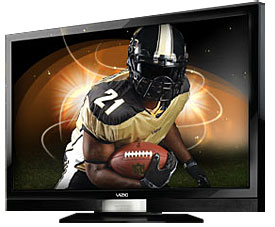
Dick De Jong
November 13, 2008
HDTV Solutions
When I take an HDTV that I am reviewing out of the box and turn it on, I'm distracted with little details like hooking up cables. I don't pay much attention to what the picture looks like.
After I settled in and turned my gaze towards the image being output by the VIZIO SV420XVT, I was amazed at the sharpness of the picture. But it went beyond sharpness. The term that came to mind was 3D.
Let me explain. We recently reviewed the Blu-ray disc, Journey to the Center of the Earth, which included a 3D version, the kind where you wear those groovy cardboard glasses.
Beyond the occasional snarling dinosaur lunging off the screen, there is an underlying 3D quality to the movie. In every scene, the foreground seems to be separated from the background. This is the 3D effect that I was seeing on this VIZIO when it was showing run-of-the-mill 2D programs.
To perform this visual 3D sleight of hand, the SV420XVT plays back the incoming video source at 120Hz, or 120 frames per second, using a technology called MEMC (Motion Estimation, Motion Compensation). Simply put, inside the TV, tiny hardworking gnomes are making constant split second decisions on how to render each frame. Unfortunately, those decisions can cause occasional unwanted results, unsightly artifacts.
To paraphrase Mother Goose, the SV420XVT reminds me of the little girl who had a little curl. When the picture is good, it's very, very good. And when it's bad, well, it needs to be tweaked. I'll go into more detail in the Setup section.
For now, I don't want to give you the wrong impression. This 1080p LCD produces a consistently superior image. The quality that you would expect from VIZIO's top of the line XVT series.
(Editor's Note: VIZIO makes a 47" version of this XVT LCD line, the SV470XVT. It has similar specifications to its 42" brother and this review can be applied to it also. In addition, they produce a 50" XVT plasma, the VP505XVT, which I will be reviewing separately.)
The design of the SV420XVT follows the traditional VIZIO elegant look of a glossy black bezel encasing a non-glare screen with a silver speaker grille below. Actually behind the silver is a center channel speaker, which is not commonly supplied on HDTVs. On either side of it and behind a matte black grille are the left and right front speakers.
Being able to clearly hear the dialogue is important to me and this center channel speaker helps to distinguish speech from background noise.
Also, for $200, you can purchase from VIZIO their WSS-1A Surround Sound Upgrade Kit, which includes a subwoofer and two small satellite surround speakers. The subwoofer connects wirelessly to the SV420XVT via a transmitter card that plugs into a slot on the Control Panel on the left side of the TV. With the WSS-1A, you can expand to a full 5.1 surround system.
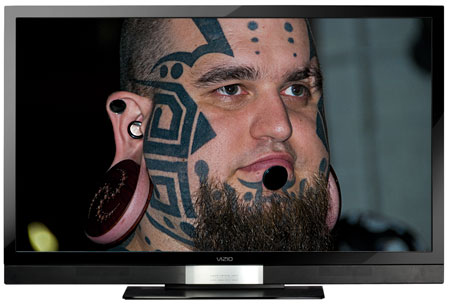
On the right side of this 46 pound (with non-swivel stand) TV is a small convenience connection panel with two HDMI inputs, one Component video (YPbPr) In and one Composite In. These latter two share a stereo Audio In.
The majority of the connections are located on the back of the cabinet and facing down. (Will VIZIO ever decide to make these more accessible?) On this panel are two more HDMIs with one matching stereo Audio In, one more Component with Audio In, one Composite with an Audio In, an S-Video, one VGA PC input with an Audio In (stereo minijack), one stereo analog Audio Out, one digital Audio Out, and a service port.
(This diagram of the panel has been split and stacked for the sake of readability.)
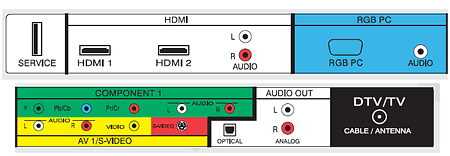
The one RF antenna connector links to integrated NTSC/ATSC/QAM tuners. Since the tuner system is Clear QAM compatible, you can attach your cable TV signal directly into the RF connector and tune in unscrambled cable stations.
For those concerned about the DTV transition coming up, the ATSC tuner is the key. With the proper antenna, you will be able to tune in digital signals broadcast over the air.
The SV420XVT does not provide a USB port for uploading JPEG photos or MP3 songs. It is a feature that I now expect on a TV, though I don't believe any of the current VIZIOs supply a USB port. Also, this HDTV has not joined the late 2008 trend of TVs with some type of Internet connectivity.

VIZIO does offer both Picture-in-Picture and Picture-outside-Picture capabilities with controls for sizing and positioning insets. You are limited in the combinations of sources. For example, you cannot PIP two HDMI sources.
The designers of VIZIO's remote controls always seem to create a new stylish element to what can be a rather mundane instrument. Beyond the bright yellow circle that lights up when you punch any button, they have added this red accent on the Power button.
Because of the remote's somewhat compact size, a few of the buttons on the bottom are small and packed tightly enough that my thumb can overlap two buttons.
One last point, the manual and on-screen help are not well written. American English is too idiomatic, especially when you are attempting technical explanations. This manual reads as if it were outsourced.
Our process of measuring the power consumption of our review units is straightforward. We plug the TV into a watt meter, called Watts up? Pro, and take a simple sampling of readings during the playback of a full screen video clip.
The first measurement is at the TV's default picture setting, which is often some form of Vivid. In fact, with the SV420XVT, it's called Vivid. This reading ranged from 237 to 238W. The manual states power consumption at 300W.
We also sampled readings at other Picture Modes at their default settings. Standard was 188 to 189W and Movie was 166 to 167W.
After we adjust the picture to our preference, which is a much less bright image than Vivid, the power consumption lowered to 129 to 130W. Of course, depending on how you like to set up your TV, your mileage may vary.
Finally, we turn off the TV and measure how much power it is using. The SV420XVT does not offer any sort of Fast Power On feature and therefore we were not surprised to see the meter drop to zero when we turned off the TV.
And once again, we expected to see a lag when we turned the TV back on. It took about fifteen seconds to display a picture, which is a little slow, but still definitely worth the savings in power.
To calibrate the HDTV, we use the the Blu-ray version of the Digital Video Essentials DVD called HD Basics. We are playing the DVD on a Pioneer BDP-94HD Blu-ray player connected to the HDTV with an HDMI cable.
We use the test patterns to adjust black level, white level, and color bias. The player is set to output a 1080p signal, which is the native resolution of the SV420XVT.
To begin, I followed my usual pre-calibration routine. First, I choose a Picture Mode that is not vivid. This VIZIO gives you a sports related range of choices: Vivid, Standard, Movie, Game, Football, Golf, Basketball and Baseball.
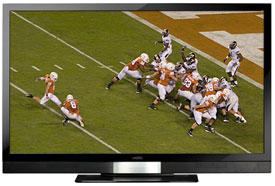
The differences between the four sports modes are minimal mostly involving the Color Enhancement options (Normal, Rich Color, Green/Flesh and Green/Blue). It's worth experimenting with them. If you feel particularly maverickish, then try the Golf mode while watching a football game.
I chose Custom and turned down the Backlight to 25 (on a scale of 100). I like to lower the Backlight because the picture looks better in our light controlled room and it saves electricity.
Next, I set the Color Temperature, which is located in the Advanced Video sub-menu. I picked Normal which is between Cool (the 9300K setting) and Warm. You can tweak any of the defaults with the individual Red, Green and Blue controls.
With those tasks completed, I work through the test patterns. I really didn't labor over the basic adjustments. The default settings for Brightness and Contrast were fine. I lowered Color (Saturation) a few notches. Tint (Hue) ended up the slightest towards green. The range for Sharpness is 0 to 7. Anything above 3 causes unsightly fringing.
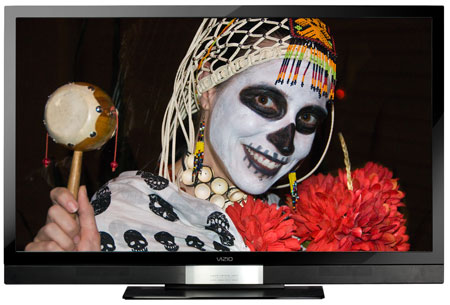
Luckily, it took only a few minutes to achieve a great looking image because I needed extra time to experiment with the Smooth Motion and Real Cinema features.
In the next few paragraphs I'm planning to get more technical than I usually do in these reviews. But if you really wish to fine tune this HDTV to your programming, then please read on. It took a couple of conversations with Calvin Lee, a Junior Engineer at VIZIO, to clarify how these features function. You won't find these specifics in the manual, though they should be there.
To begin, the native playback rate of the SV420XVT LCD is 120Hz or 120 frames per second. In the U.S., broadcast TV content is 60Hz. To convert programs to the 120 frame rate, the TV's video processing chips have to create extra frames. The two common methods entail either simply duplicating the original frame or rendering a completely new frame, which requires a lot of calculations.
The easiest way of describing the task is through images with moving elements. This example is also informative because the main reason for 120Hz playback is that the extra frames smooth out the perception of motion, while exhibiting less blur and a sharper picture.
Let's take two consecutive frames from a 60Hz program, where one in-between frame needs to be manufactured by the TV to bring the frame rate to 120 per second. This interpolated frame is produced through a process called MEMC (Motion Estimation, Motion Compensation).
In this simple example a butterfly is flitting from left to right and a leaf is falling. The processing chips are looking at both frames, (actually, they often sample a series of frames), and estimate where the butterfly and leaf would be in the new middle frame, labeled 1a.
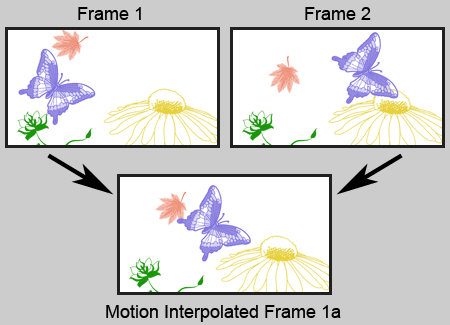
Now multiply the complexity of the image with multiple leaves fluttering in the wind, and butterfly wings flapping, and trees in the background swaying, and you begin to understand the difficulty of creating a smooth artifact free image.
Add to that task playing back film, which is shot at 24 frames per second. If the Blu-ray player can output this native 24 fps, then the VIZIO must create four new motion interpolated frames between each original frame.
As a final topper, each film and TV program can present its own unique set of challenges to those tireless video processing elves toiling away in the TV.
Simply there is no one setting that works best for every program. Therefore the engineers at VIZIO provide a couple of adjustments that directly effect how the MEMC functions.
Nested in the Advanced Video submenu, the Smooth Motion Effect and Real Cinema controls are the keys to tweaking motion estimation and motion compensation. If you experience artifacts, you should experiment with these settings.
Smooth Motion Effect has four options: Off, Low, Middle or High. If you turn it Off, then the TV does not perform motion interpolation. It simply repeats frames to obtain 120 frames per second. If the source is 60Hz, then every frame is duplicated once.
By deactivating Smooth Motion, in effect, you are replicating the look of a traditional 60Hz LCD. You lose that sharp 3D look and you may encounter some judder. Why, you may ask, would you ever turn it Off? Some people prefer a softer, more film-like and less video-like sharp look. Switching Smooth Motion Effect off will tend to be softer.
The Low, Middle, and High settings dictate how aggressive the MEMC is. On Low, only the most active portions of the picture are treated as dynamic and therefore are included in the motion estimation, motion compensation calculations. As you go to Middle and High, slower moving parts of the picture are included.
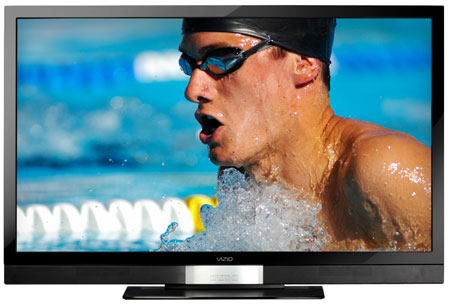
Now, as the name implies, the Real Cinema setting only applies to 24Hz sources, which you will only encounter with Blu-ray (and HD DVD) players that can output the native 24 fps of a movie. It does not effect HD movies on TV channels like HBO, which do not broadcast them at 24Hz.
With Real Cinema, you have three options, Off, Smooth, and Precision. Off works like previous control, it disengages motion interpolation. With 24Hz sources, each frame needs to be duplicated four times to reach 120 fps.
When Smooth is selected, the TV does the full interpolation, taking a frame of the original and creating four distinct in-between frames. As the name implies, this setting should provide the smoothest, judder-free picture.
With the massive amount of calculations involved with the Smooth setting, you might expect a hiccup occasionally. The manual describes the most obvious culprit that I saw as a halo. I think of it as a bubble.
For example, in one scene in the Pride and Prejudice HD DVD, Miss Elizabeth quickly walks away from Mr. Darcy and descends a staircase with leafy bushes in the background. The camera tracks her in the shot, keeping her in the middle of the frame.
She stays sharp, but as the MEMC contends with the camera quickly panning over the noisy, leafy background, a halo or bubble forms around Elizabeth. The bushes around fuzz up and distort as if they are being seen through a bubble.
Before I continue, this halo effect lasted no more than ten seconds and if you weren't paying close attention, you would not notice it. Also, the movie is over two hours long, and I probably did not see more than 30 seconds in total of this bubble artifact. For most viewers, it simply is not that big of deal and a fair tradeoff for the picture quality that this Smooth option produces with 24 fps movies.
If instead of the halo, you would prefer a little judder from time to time, then switch to the other Real Cinema option, Precision. With this choice, the TV performs motion interpolation to generate 60 frames from the original 24 and then simply duplicates each of the 60 to obtain 120Hz.
This is supposed to alleviate the halo. In fact, in the Elizabeth descending the stairs scene, it did not. The only solution was to turn Real Cinema Off. Though, in other shots where I noticed a slight halo with the Smooth setting, turning to Precision did work.
As I said, you need to experiment and decide what you prefer. For me, with certain movies, I like the 3D sharpness and am willing to trade for an intermittent blip.
For example, in Pirates of the Caribbean: At World's End, in the climatic scene when the Endeavor and her crew are literally blowing up around the unblinking Cutler Beckett as he descends his final set of stairs, the clarity of the shards of ship swirling in slo-mo around him is stunning.
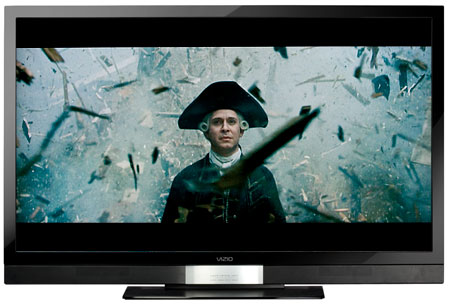
The three dimensional quality of the shot is strongest when Real Cinema is set to Smooth. In a later scene, I notice a bit of flutter in the ropes in the background, but it's fleeting. At least with Pirates, it's Smooth sailing for me.
After that dissertation, I don't have too much more to add about the performance of this XVT VIZIO.
As with most HDTVs, the SV420XVT, even with all of its video processing brawn, cannot raise standard definition programs to high definition quality. They look OK, but don't expect Blu-ray HD, not even close.
With HD sources, especially movies, the main quandary I faced was how sharp should the image be. I have seen thousands of films in theaters and on TV, which has imprinted an idea in my mind's eye of what I think movies should look like and this ultra-sharpness is not it.
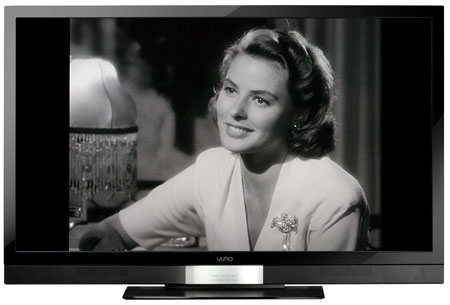
With new visual effects laden films like Transformers, I prefer the crisp details. The dilemma comes with classics like Casablanca. When I watch the HD DVD in this motion interpolated clarity, it gives me pause. I know some film zealots that would wince and disparage it as looking like video.
For me, I'm grateful for that extra clarity in Ingrid Bergman's radiant eyes and luminous smile. If I find a film that I wish to soften, I'll turn Real Cinema Off.
To bring me back from my Ingrid reverie, let me remind you that the SV420XVT is an LCD. Its blacks are not as deep as the best plasmas and its viewing angle is still limited. I would suggest sitting no farther than 45 degrees off angle. Even though the image is decent at a more severe angle, you will be losing optimum picture quality.
I connected my laptop to the TV with a VGA cable. I was able to set the video card to output 1920 x 1080. When I picked the PC input on the VIZIO, it automatically adjusted.
The PC mode has its distinct Picture Menu, which includes settings for Brightness, Backlight, Contrast, and Color Temperature. The display of images in Photoshop and text on the Internet looked wonderful. I'm tempted to consider this HDTV as a great 42" computer monitor.
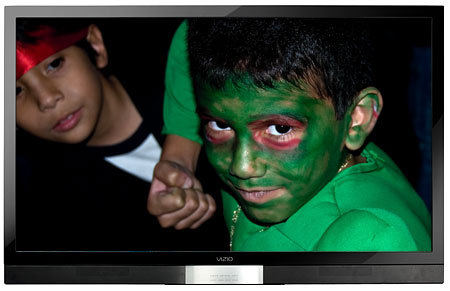
As I mentioned previously, the three speaker package integrated into the SV420XVT is a real plus. I'm not a big fan of the tiny two speaker audio systems common in HDTVs. This VIZIO's speakers aren't any bigger, but the center channel does supply depth and breadth to the sound and definitely punches up the dialogue track.
I also appreciate the extra controls in the Audio menu. The presets provide a good starting point and then you can tweak the five band graphic equalizer to fine tune the speakers' output.
I give the three channel high marks, but if you really desire a deeper, fuller bodied sound, then spring for the WSS-1A Surround Sound Upgrade Kit.
The VIZIO SV420XVT is a high performance sports car that can deliver top notch picture quality. But like a race car, you will have to get under the hood occasionally to tune it for different road conditions. If you don't like getting your hands dirty, then look to a more all-utility vehicle, something like the VIZIO VO42LF.
Posted May 8, 2010 3:00:57 PM
By Patricia Hokenstad